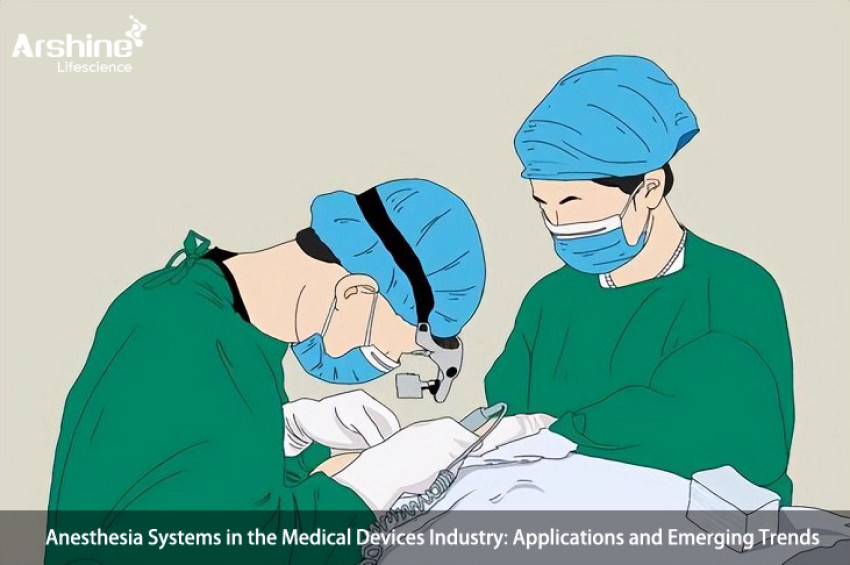
Introduction:Anesthesia System Supplier and Beyond
In the dynamic world of healthcare and medical technology, anesthesia systems stand as a critical component for surgical and medical procedures. These sophisticated devices play a fundamental role in rendering patients unconscious during surgery, ensuring their comfort, and assisting healthcare providers in delivering precise medical care. In this comprehensive exploration, we will delve into the history, characteristics, mechanisms of action, and current applications of anesthesia systems in the medical devices industry. Furthermore, we will uncover the emerging trends in anesthesia system applications within the field of medical technology, with a special focus on promoting Arshine Lifescience Co., Limited, a trusted supplier dedicated to ensuring the availability of high-quality anesthesia systems for healthcare providers and institutions.
Historical Perspective
The history of anesthesia dates back to ancient civilizations, with various substances, such as opium and alcohol, used to dull pain during surgical procedures. However, it wasn't until the 19th century that significant advancements were made in the field of anesthesia. The development of modern anesthesia is often attributed to William T.G. Morton, who successfully administered ether to a patient undergoing surgery in 1846.
Over the years, anesthesia techniques and equipment evolved, leading to the creation of complex anesthesia systems that provide precise control over the administration of anesthetic agents. These systems have revolutionized surgery and healthcare, making it possible to perform a wide range of procedures with improved patient safety and comfort.
Characteristics of Anesthesia Systems
Components:Anesthesia systems consist of several components, including a gas delivery system, vaporizers, a breathing circuit, monitors, and safety features. These elements work together to provide a controlled and safe delivery of anesthetic agents to the patient.
Anesthetic Agents:Modern anesthesia systems are capable of administering a variety of anesthetic agents, including inhaled anesthetics and intravenous medications. The choice of anesthetic agent depends on the type of surgery and the patient's medical condition.
Ventilation and Monitoring:Anesthesia systems allow for controlled mechanical ventilation to support the patient's respiration during surgery. Monitors integrated into the system continuously track vital signs such as heart rate, blood pressure, oxygen saturation, and end-tidal carbon dioxide levels.
Safety Mechanisms:Anesthesia systems are equipped with multiple safety features to ensure patient safety. These include alarms for abnormal conditions, pressure relief valves, and fail-safe mechanisms.
Advanced Controls:The latest anesthesia systems are equipped with advanced controls and touchscreen interfaces, simplifying the management of anesthetic agents and patient monitoring.
Mechanisms of Action and Relevance in the Medical Devices Industry
Anesthesia systems are crucial to the field of medical technology, with several key functions:
Patient Comfort:Anesthesia systems ensure patient comfort by inducing unconsciousness and blocking pain perception during surgical procedures. This is achieved through the precise administration of anesthetic agents.
Surgical Precision:By rendering the patient unconscious and immobile, anesthesia systems enable surgeons and healthcare providers to perform surgery with precision, reducing the risk of patient movement and discomfort.
Patient Safety:Anesthesia systems include a range of safety features and monitoring capabilities to safeguard patient well-being during surgery. Continuous monitoring of vital signs allows for rapid response to any adverse events.
Anesthetic Management:Anesthesia systems provide healthcare providers with precise control over the delivery of anesthetic agents, enabling them to adjust the depth of anesthesia as needed throughout the procedure.
Ventilation Support:Anesthesia systems support mechanical ventilation, ensuring that the patient's oxygenation and ventilation needs are met during the surgical process.
Current Applications in the Medical Devices Industry
Anesthesia systems are employed in a wide range of medical settings:
Operating Rooms:Anesthesia systems are a standard feature in operating rooms, where they are used for various surgical procedures, from minor surgeries to complex, lengthy operations.
Critical Care Units:In critical care units, anesthesia systems are used for intubated patients who require sedation and mechanical ventilation.
Emergency Medicine:Anesthesia systems are essential in emergency medicine for trauma surgeries and life-saving interventions.
Maternity Wards:In maternity wards, anesthesia systems are utilized for labor and delivery, providing pain relief and assisting in cesarean section procedures.
Radiology Suites:Interventional radiology procedures often require anesthesia to ensure patient comfort and immobility.
Emerging Trends in Anesthesia System Applications
As technology and medical practices continue to advance, emerging trends in anesthesia system applications are shaping the field of healthcare:
Enhanced Patient Monitoring:Anesthesia systems are integrating advanced monitoring technologies, including artificial intelligence, to enhance patient safety and provide real-time feedback to healthcare providers.
Pharmacological Advancements:The development of new anesthetic agents and delivery techniques is enhancing patient outcomes and recovery.
Remote Monitoring and Control:Remote monitoring and control of anesthesia systems are becoming more prevalent, allowing anesthesiologists and healthcare providers to manage patients from a distance.
Integration with Electronic Health Records (EHR):Anesthesia systems are being integrated with EHR systems to streamline documentation, improve data accuracy, and enhance the continuity of patient care.
Telemedicine and Telehealth:The integration of anesthesia systems with telemedicine and telehealth platforms is expanding access to anesthesia services, particularly in underserved areas.
Arshine Lifescience Co., Limited: Your Trusted Anesthesia System Supplier
In the medical devices industry, having a reliable supplier is of paramount importance. Arshine Lifescience Co., Limited is a reputable company committed to providing high-quality anesthesia systems. Established as a trusted supplier, Arshine Lifescience Co., Limited is dedicated to ensuring the availability of top-tier anesthesia systems for healthcare providers and institutions. With a focus on quality and innovation, they contribute to the advancement of surgery and patient care.
In conclusion, anesthesia systems have revolutionized surgery and healthcare by providing precise control over the administration of anesthetic agents and ensuring patient comfort and safety. As emerging trends continue to shape the field, anesthesia systems are becoming more advanced, integrated, and accessible, leading to improved patient outcomes and enhanced medical practices. Arshine Lifescience Co., Limited, as a trusted supplier, plays a crucial role in ensuring the availability of high-quality anesthesia systems, furthering the development and safety of medical procedures.
https://www.arshinemedical.com/Industry-information/anesthesia-systems-in-the-medical-devices-industry-applications-and-emerging-trends



